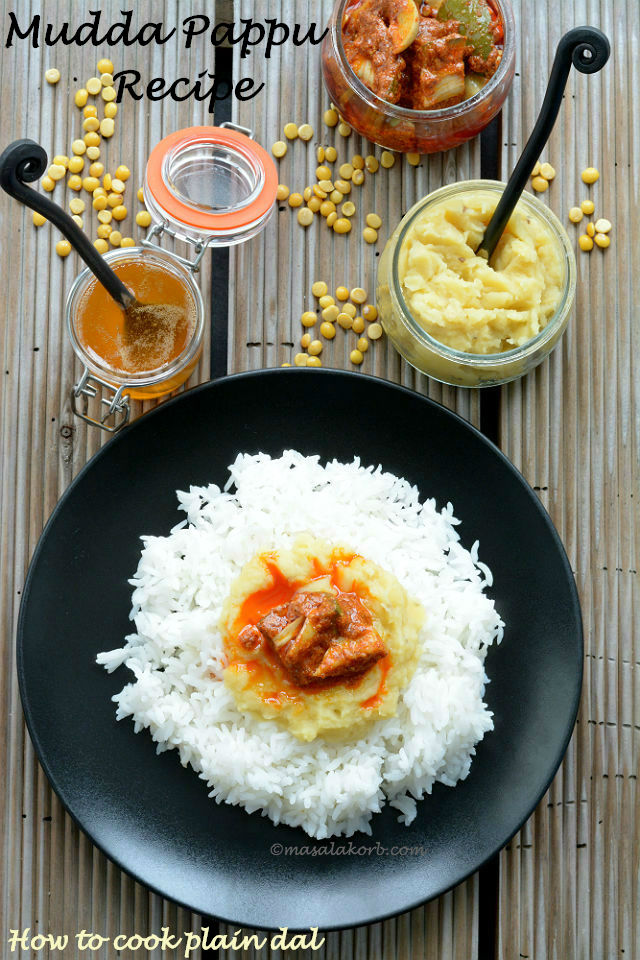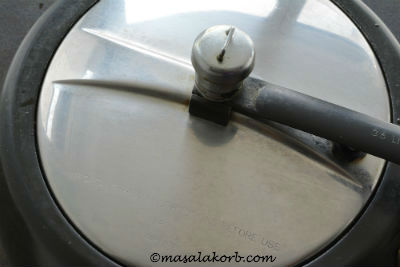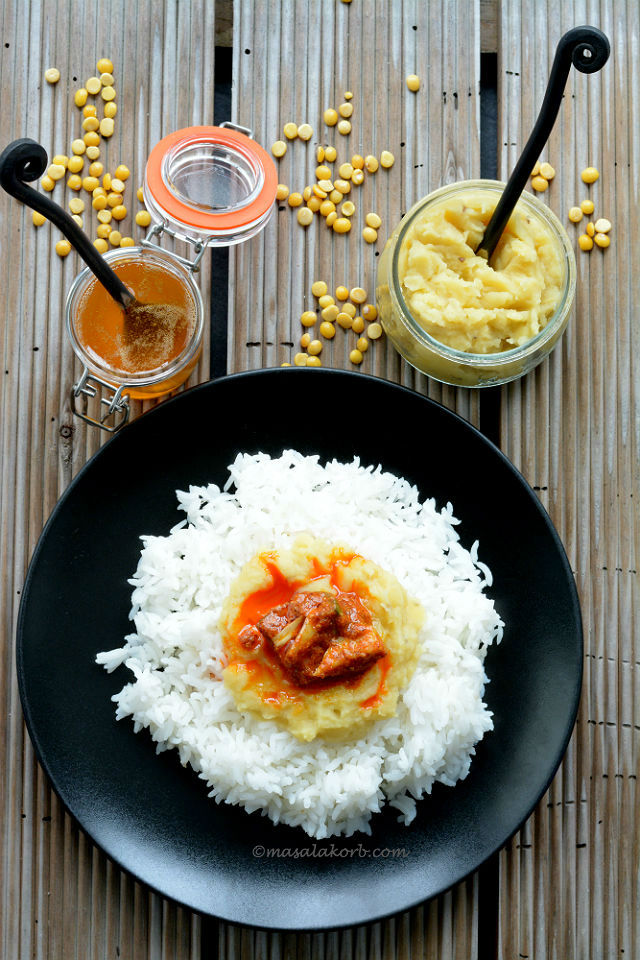 Mudda Pappu Recipe is the quintessential comfort food in most Indian households. No Indian meal is complete without the protein packed superfood, dal, which continues to be our culinary tradition throughout the length and breadth of the country since ages. Mudda pappu (plain dal) marks the sumptuous beginning of any Andhra thali without which the lunch or dinner is incomplete.
Mudda Pappu Recipe is the quintessential comfort food in most Indian households. No Indian meal is complete without the protein packed superfood, dal, which continues to be our culinary tradition throughout the length and breadth of the country since ages. Mudda pappu (plain dal) marks the sumptuous beginning of any Andhra thali without which the lunch or dinner is incomplete.
Now the golden question….Why am I sharing How to cook plain dal? Some of you are aware that I have been conducting cooking workshops here in Hannover. In one of the workshops, I had a recipe using dal and it was quite a task for the participants to cook dal. They had asked me if I had it on my blog and that’s when I realised how I could miss out such a simple Mudda Pappu Recipe. It is also the base for sambar, an important accompaniment in South Indian cuisine. So, this is for you guys and of course for all the novice cooks out there struggling to get their dal right!!
Nutritionally, lentils are an excellent source of folate and a good source of fibre, protein, iron, and potassium,making them a healthy staple for vegetarian diets. They’re healthy and hard to screw up. You should be cooking them all the time, especially for a quick, easy, guilt-free lunch.
Did you know that proteins need some amount of fat to digest well? That explains the reason behind a generous dose of ghee we add to any form of dal. Trust me it also tastes yummy!!![]()
Mudda Pappu Recipe is very simple to prepare and requires not more than couple of essential ingredients. When cooked right, these lentils are chewy yet tender, are very flavourful and comforting. This traditional Indian vegetarian meal known as pappu-annam as we call it at home or as dal-chawal in North India is simple, highly nutritious and comforting. Indian toddlers and children are fed a nutritious diet of lentil and rice with a dollop of ghee (clarified butter) during their growing years. It is best eaten mixed with hot steamed white rice, a dollop of ghee and the famous Andhra avakaya pachadi (raw mango pickle). Mere words cannot describe the magical flavour of this plain dal and comfort of this delicious combo.
Once cooked, your lentils are ready for any kind of culinary action you want to throw at them.
Off to Mudda Pappu Recipe!!
Easy steps to follow for Mudda Pappu Recipe:
I usually use the pressure cook method to cook my lentils because it saves time and energy. But you can also use the stove top method, which will also be explained below.
Pressure cooker method:
- Measure and transfer the lentils into a bowl, strainer or colander. Pick over and remove any shrivelled lentils, debris, or small rocks. You’re probably not going to find a pebble in your lentils—but it’s worth a quick look.

- Thoroughly rinse under running water. Transfer to a bowl and add sufficient water and let it sit for 10 minutes (optional). Soaking time is not a must for lentils.

- Transfer lentils along with water to a pressure cooker. You can also add a pinch of turmeric to the lentils (optional). It’s purely your choice.

- Close the pressure cooker with the lid and cook over medium high heat for about 3 whistles. Then simmer on low heat for 5 minutes and turn off the heat.

- Open the lid of the pressure cooker once the pressure subsides.
- Add salt to taste and mash it well. The consistency should be such that if you serve a ladle of Mudda Pappu it retains the shape of the ladle…it shouldn’t be too runny. The dal also hardens a bit as it cools down.

What complements the mudda pappu best is a little bit of ghee (clarified butter), along with a serve of piping hot rice and avakaya pachadi (raw mango pickle) in your platter. It is also eaten in combination with sweet & sour flavoured gravy called “pulusu” or with rasam (chaaru).
Other Ways to Savour Mudda Pappu:
- Probably the best way to savour mudda pappu annam is to have each mouthful with a spicy pickle such as Avakaya along with it.
- Rasam or Charu is also an excellent accompaniment to Mudda Pappu Annam. It does not really matter what type of rasam but I love pepper rasam with some mudda pappu mixed in it and a pappad or an omelette on the side.
- It forms the base for most varieties of sambar and many dal varieties.
- It is also used as an accompaniment to a few desserts. I can see the question mark on your face. Yes… you heard it right..it’s savoured along with paramannam (rice payasam) and also pal thalukulu. I’m not a big fan of this combo but there are many who adore it.
- You can also add lentils to salads. If adding lentils to a salad or if you desire a firmer textured lentil in your soup or stew, only cook them until they have a tender but firm texture.
Stove top method to cook Lentils:
- Measure and transfer the lentils into a strainer or colander. Pick over and remove any shrivelled lentils, debris, or small rocks.
- Thoroughly rinse under running water.
- Transfer the rinsed lentils to a saucepan and pour in required water.
- Bring the water to a rapid simmer over medium-high heat, then reduce the heat to maintain a very gentle simmer. You should only see a few small bubbles and some slight movement in the lentils. Stir the lentils occasionally. The lentils are cooked when the water has been absorbed and they taste tender.
- Cook, uncovered, for 20 to 30 minutes. You may have to add water as needed to keep the lentils slightly submerged.
- Lentils are cooked as soon when the water has been absorbed and they are tender and no longer crunchy. Stir in salt to taste and mash well.
Mudda Pappu Recipe | How to Cook Plain Dal (Lentils)
Ingredients
- 1 cup Tuvar dal Toor dal, kandi pappu or yellow lentils
- 2 Cups water to boil lentils enough water for the lentils to immerse
- Salt to taste
Instructions
- Pressure cooker method:
- Measure and transfer the lentils into a bowl, strainer or colander. Pick over and remove any shrivelled lentils, debris, or small rocks.
- Thoroughly rinse under running water. Transfer to a bowl and add sufficient water and let it sit for 10 minutes (optional). Soaking time is not a must for lentils.
- Transfer lentils along with water to a pressure cooker.
- Close the pressure cooker with the lid and cook over medium high heat for about 3 whistles. Then simmer on low heat for 5 minutes and turn off the heat.
- Open the lid of the pressure cooker once the pressure subsides.
- Add salt to taste and mash it well.
- Stove top method:
- Transfer the rinsed lentils to a saucepan and pour in required water.
- Bring the water to a rapid simmer over medium-high heat, then reduce the heat to maintain a very gentle simmer. You should only see a few small bubbles and some slight movement in the lentils. Stir the lentils occasionally. The lentils are cooked when the water has been absorbed and they taste tender.
- Cook, uncovered, for 20 to 30 minutes. You may need to add water as needed to keep the lentils slightly submerged.
- Lentils are cooked as soon when the water has been absorbed and they are tender and no longer crunchy. Stir in salt to taste and mash well.
Notes
2. The cooking time of dal can be slightly reduced if the lentils are soaked for 15-20 minutes before pressure cooking them.
3. Always add salt to the dal after it is cooked, otherwise the lentils will remain hard.
4. Cooking times will also vary depending on the age of the lentils, which affects their moisture content.
5. If adding lentils to a salad or if you desire a firmer textured lentil in your soup or stew, only cook them until they have a tender but firm texture.
6. Similarly split yellow moong dal (pesara pappu) can be cooked on the same lines as tur dal and eaten with white rice and ghee. Pesara pappu cooks faster.
7. Dry roasting lentils and then cooking them will give a nice aroma to the plain dal.
8. Never miss an opportunity to add more flavour to your lentils if you do not like it plain—they can take a LOT.
Do check out other popular lentil/dal recipes from blog.
Many more to come!!…..Stay Tuned!!
Happy Cooking 🙂
Cheers!!
Padma.








I am just curious about the taste of this plain dal… looking forward to it…
Oh then you must try the combo…I can assure you will like it..Thanks priya 🙂